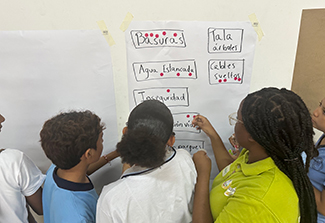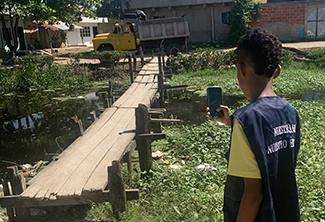Our Voice helps citizen scientists—ages 7 to 100—address childhood health
May/June 2025 | Volume 24 Number 3
 Photo courtesy of Our VoiceAn Our Voice citizen scientist decides which issues to prioritize for a presentation.
Photo courtesy of Our VoiceAn Our Voice citizen scientist decides which issues to prioritize for a presentation.
Childhood obesity is familiar research territory for Abby King, PhD, a professor of epidemiology and population health at Stanford Medicine. How researchers interrogate common health issues is crucial. “A lot of my research (I'm a clinical psychologist by training) started out on the very individual and group level of intervention, but then I got really frustrated because treating people is not what I wanted to do—I wanted to prevent what was going on to begin with!”
She developed a socioecological framework as her guiding principle when designing interventions. This approach, which considers both social and ecological factors while examining the processes that influence them, also informed her work as scientific co-chair of the Fogarty-led special issue in Obesity Reviews, "Childhood Obesity Prevention Across Borders: The Promise of US-Latin American Research Collaboration."
In that publication, she fused “incredible policy level” research done in Latin America with “individual, interpersonal community level” research done in the U.S. “Clearly, obesity prevention in childhood is very important, yet it’s also important to work across the life course and intergenerationally, because kids obviously don't live by themselves, and we know that cross-generational obesity prevention interventions can be potent.”
These days King is most passionate about
Our Voice (Nuestra Voz), an initiative that “turns everybody into citizen scientists who then collect meaningful health-related data for their own communities.” To guide novices through the Our Voice process, King’s lab developed the
Discovery Tool, a multilingual app that is currently “in 14 languages and counting.”
 Photo courtesy of Our VoiceChildren in Daly City, California, gather for an Our Voice presentation.
Photo courtesy of Our VoiceChildren in Daly City, California, gather for an Our Voice presentation.
Discovering empowerment
Anyone can learn the app in just minutes and use it to identify and understand the barriers to healthy behavior in their neighborhood, school, workplace or wherever they wish to study, says King. Take, for example, a group of neighbors who want to examine barriers to accessing healthier foods, including how easy or difficult it is to walk in their community. Using the Discovery Tool, these citizen scientists would first collect data and then interpret this information together. Next, they’d prioritize issues, and, in a facilitated process, present their research and possible solutions to “community decision-makers and policymakers—the people who really hold the reins of change.”
“We've had citizen scientists as young as 7 years old all the way up to 100,” says King. “Some of our best work in Mexico and Colombia focuses on intergenerational citizen scientists—abuelos and abuelas walking around with their grandchildren, each seeing things differently yet sharing their differences.”
Our Voice performs equally well in the U.S. Elementary school students in Daly City, California, who wanted to know, How can we make it easier to walk or bike to school?, turned to the Discovery Tool to collect data on dangerous and difficult conditions preventing these healthy activities. Next, the children, who were backed by their county’s Department of Education and other community partners, discussed and prioritized issues. Finally, they presented their work to the city council, made suggestions and asked for help.
“Now, if it had been a scientist, people would have applauded politely,” says King. Instead, the council responded enthusiastically.
“You need to grab people’s hearts and kids can do that.”
Scientific connection
“What I bring to
Our Voice is the inclusion of artificial intelligence (AI) into the process,” says Eduardo de la Vega, a Fogarty-funded post-doc in Abby’s lab. Once participants reach the sharing and discussion phase of the process, they can use the Stanford version of chatGPT to help form solutions, he explains. For example, a group of teens in El Pozón, an impoverished area in Cartagena, Colombia, wanted to fix road- and building- related holes that had become pools of stagnant water attracting dengue-carrying mosquitoes.
Iterating their proposed solution of filling the holes with cement or sand, the AI steered them toward the use of a cement lid as a temporary solution that would not interfere with future construction plans. The AI capabilities of Photoshop also generated new images from one of the teen’s existing photos to reveal how the repaired holes might look in the future. “By interacting with AI, citizen scientists improve their solutions and make them more feasible.”
Community engagement efforts also benefitted from de la Vega’s attention. “In many places you cannot just invite major players or those holding formal offices to stakeholder meetings.” To extend the political reach of citizen scientists, he incorporated social network analysis into the process to help identify those capable of mobilizing change. “Other relevant systems or people, such as NGOs working in the area or community leaders, may be doing similar work. If you don't do a rigorous search, you may miss the very people who are most likely to make solutions happen.”
 Photo courtesy of Our VoiceEl Pozón teens collaborate on a Safe Routes to School project.
Photo courtesy of Our VoiceEl Pozón teens collaborate on a Safe Routes to School project.
Global influences
Sadly, childhood obesity is a crisis that trespasses all borders. Working in lower resource nations in regions outside the Americas, King often sees “everybody buying prepackaged foods because that is the sexy new thing to do.” Environments become “obesogenic” when eating is a mindless activity and technology removes “so much of our naturally occurring behavior that is required to not get obese.”
Humans weren’t built for so much abundance, but for hunting food, seeking food, burning calories, says King. “The commercialism and easy convenience of the food environment, which drives our global economy and which we all benefit from in many ways, can be dangerous for health worldwide and lead to obesity.”
As an engineer-psychologist, de la Vega also emphasizes the impact of the environment on human development. “If you improve the environment, you don't have to try to change or heal the individual so much—improving the environment is a population-level intervention.” Given that childhood obesity is a shared, global problem, international collaboration is appropriate as it leads to shared knowledge, he says, adding that, when focusing on a universal issue, U.S. research dollars go farthest in more affordable countries.
“What you do with $1 in the U.S., you can do 10 times in Colombia.” How Latino populations like to solve problems is similar whether they live in the U.S. or in Latin America, he notes. “A lot of knowledge from Colombia about culturally sensitive approaches to improving health for Latino population can translate to the U.S.”
King agrees. “We learn by working with other cultures because innovations around citizen science and how to motivate children, so much of it comes from Colombia and other countries. When new strategies pop up in other countries, we bring them to the U.S.” This is not a one-way street. When American students placed their data-gathering photos in a public space, a kind of pop-up museum, to share what’s happening with their entire community, other countries soon incorporated this into their own programs.
 Photo courtesy of Our VoiceA teen in El Pozón uses the Discovery Tool, embracing his role as a citizen scientist.
Photo courtesy of Our VoiceA teen in El Pozón uses the Discovery Tool, embracing his role as a citizen scientist.
American voices
King’s lab has now completed
Our Voice projects in more than 25 countries plus “18 U.S. states and counting.” Community-engagement doesn't just empower residents, it empowers scientists, she says. “So much science doesn’t get put into action right away, but with participatory research you see the community impacts immediately.”
Effects are also lasting. A U.S. study found that end-of-year walking/biking to school was significantly higher when schools added Our Voice to a standard Safe-Routes-to-School curriculum (compared to when schools did not).
“We work directly with every group—Our Voice is remote and so accessible,” says King. Recently, she and her colleagues spoke to West Virginia transit officials hoping to enlist young citizen scientists to help them make statewide changes intended to increase children’s activity levels and so improve their overall health.
“To work with children is just unbelievable—they're so excited to have a voice.”
More information
To view Adobe PDF files,
download current, free accessible plug-ins from Adobe's website.